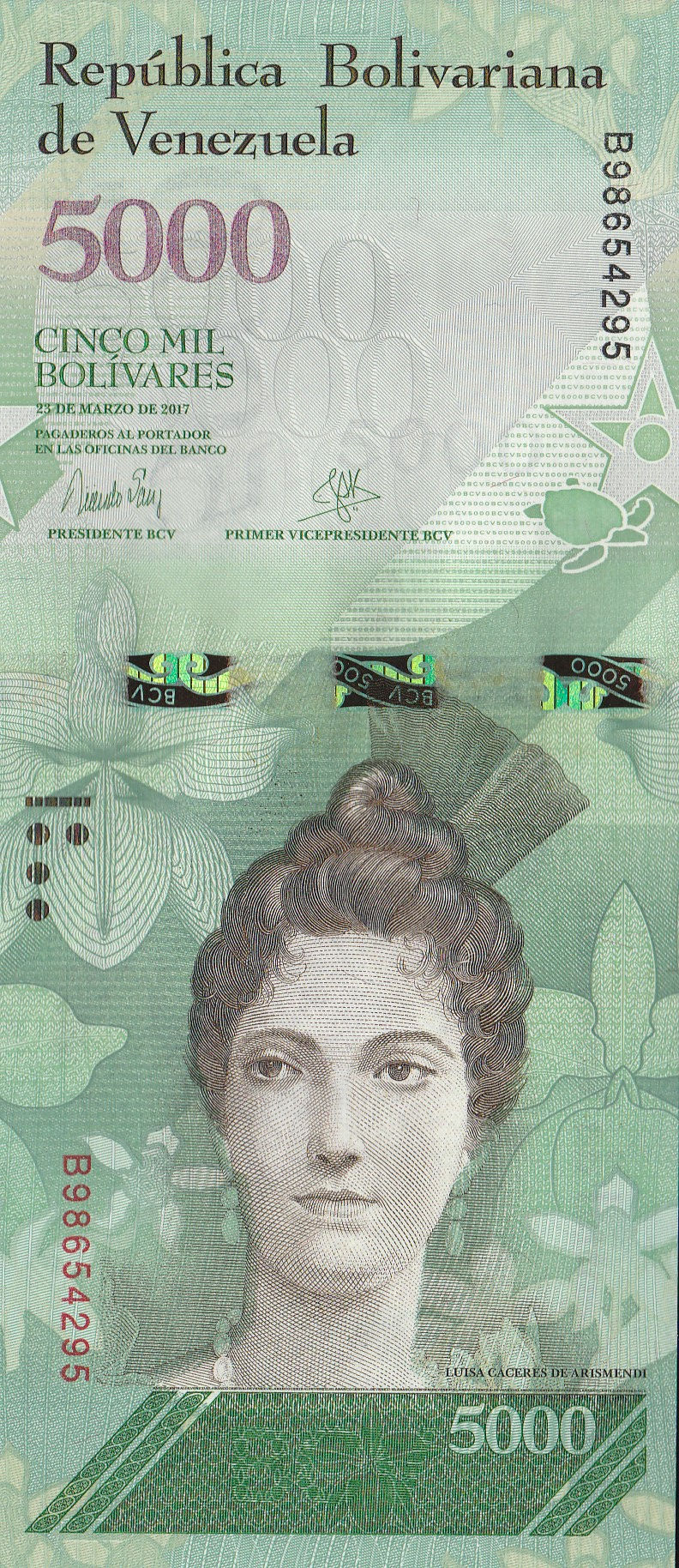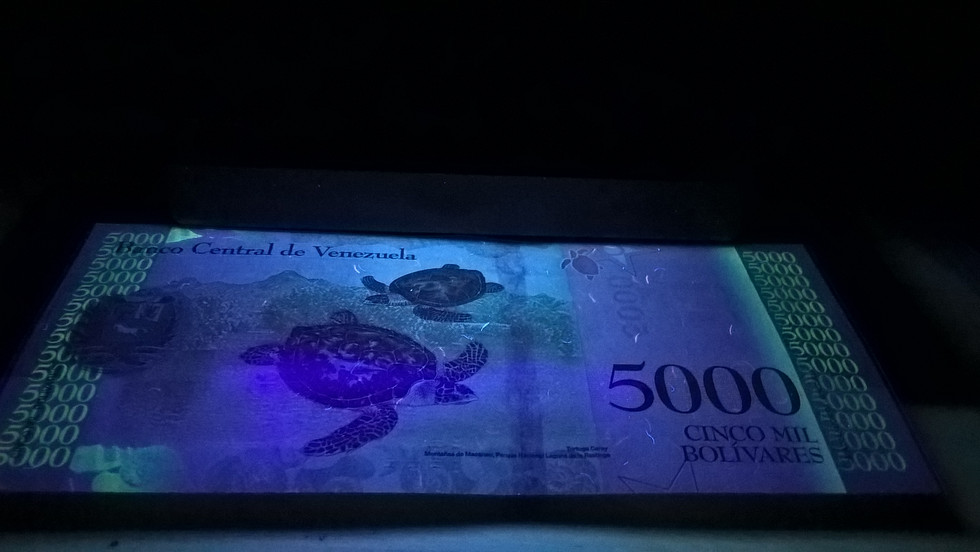This Venezuelan banknote represent the 4th denomination of the Bolívar Fuerte Series (2016). The 5,000 Bolívar Fuerte note (5000 BsF) was printed from August 18, 2016 to December 13, 2017. This particular note was produced during the 23 March 2017 printing run.
Rampant hyperinflation has caused all Bolívar Fuerte denominations to be retired. Including its successor, the Bolívar Soberano (2018). Which currently (2020) has been retired up to it's final denomination, the 500 Bolívar Soberano (500 Bs.F.).
Despite this, retired Venezuelan Bolívar have found a new home. As an easily affordable item for beginning/young collectors. These collectors often become attracted, by the colorful illustrations of Venezuela’s wildlife. Creating decorative displays, with the reverse side out. In honor of that tradition, this note will be reviewed reverse first.
Reverse

The Reverse features endangered Hawksbill Sea Turtles, also known as “Tortuga Carey” in Spanish.
A population of Hawksbill live off coast of Venezula, in the Caribbean Sea. They spend the majority of their time swimming amongst tropical coral reefs. Feeding on sea sponges and resting in underwater caves. Once a year the hawksbill will lay their eggs on remote beaches and islands. Such as the Laguna de la Restinga, on Margarita Island.
The average adult Hawksbill Sea Turtles grows to 1 m (3 ft) long and weighs around 80 kg (180 lb). The heaviest Hawksbill ever recorded weighed 127 kg (280 lb). It's shell is amber covered, with light and dark streaks. With colorful black, brown and green patterns.
A little known fact is the effect the hawksbill's diet has on its physiology. Hawkbill are the first bio-luminescent reptile to be recorded. Currently this feature is believed to be caused by the consumption of bio-luminescent hard coral. Additionally hawksbill that consume large quantities of cnidaria (jellyfish, man-of-war, and sea anemone), are poisonous to predators.
Laguna de la Restinga
The background is an illustration of Macanao Mountain, located on Margarita Island. Western Margarita Island is nature reserve (Laguna de la Restinga). Laguna de la Restinga was created on 6 February 1974, by decree of the Venezuelan government. The park is famous for it's beaches and annual Hawksbills nesting.
It initially covered an area of 10,700 hectares (26,000 acres). The current park features a 2,500 hectares (6,200 acres) lagoon, fringed by mangroves and features number of mangrove islands. The lagoon cointains 18 kilometres (11 mi) of channels. The lagoon is separated from the Caribbean Sea by a narrow sand bar, renown for its sea shells.
This sand bar is over 15 miles (24 km) long, spanning from the fishing community of La Guardia to the Macanao Peninsula. The peninsula is of great environmental concern and is the only home of the endangered yellow-shouldered amazon parrot. On 4 September 1996, Laguna de la Restinga became a member of the Ramsar Convention on Wetlands. There is a proposal for a Macanao Wildlife Reserve, containing the Chacaracual Community Conservation Area (CCCA).

Observe
The vertical observe features Venezuelan national heroine Luisa Cáceres de Arismendi (1799-1866). Luisa de Arismendi is a recognized member of the Panteón Nacional de Venezuela (National Pantheon of Venezuela). As one of the heroines of the Venezuelan War of Independence (1810-1823). The University Institute Luisa Cáceres de Arismendi, in Caracas is named in here honor.
Countermeasures
Despite the low value of the Bolívar Fuerte, the series utilizes numerous security measures. Both visible and virtually hidden. The Fuerte series alternates between standard and window security strips, throughout it's denominations. This denomination utilizes a jeweled, windowed security strip. The strip displays "BCV5000" in sequence, running along a flowing ribbon pattern. There is additional green-gold holographic inlays, warped around the ribbon pattern. The segmented "bar" and 4 circles above the (red) serial number, are a denomination designator. Which alternates between the denominations within the series. There is a 2-color light puzzle, below the (black) serial number. Light green (observe) and gray(reverse) segments merge, when back lit. Highlighting a Sea Turtle and star.

Micro-Print
The near entirety of the note is covered in alternating lines and micro-print patterns. Where present the micro-text reads “BCV5000”, in sequence. The pattern repeats on all denominations, with the exception of the number (listed denomination). Below the observe's portrait is a orchid floral pattern. Overlaid by a large micro-print patterned “BCV”.
Watermark
The watermark features de Arismendi, as seen on the note's observe. Below the watermark is an electro-typed text "5000". Unfortunately the color pallet and erratic micro-print lines makes capturing the watermark difficult. Although it can be readily seen, in physical copies of the note.
UV Gallery
Bolívar Fuerte Gallery (Observe)
(Gallery features all observe sides of the Bolívar Fuerte)
Bolívar Fuerte Gallery (Reverse)
(Gallery features all reverse sides of the Bolívar Fuerte)
Additional Notes
A statue of was erected in Luisa de Arismendi's honor, in the small town of La Asunción, where she was married.
Luisa de Arismendi was detained at the Fortress of Santa Rosa on Margarita Island. In an effort to forced her husband General Juan Bautista Arismendi (1775-1841), to halt his independence efforts.
General Arismendi remains are also interned at the Panteón Nacional de Venezuela (National Pantheon of Venezuela).




























































Comments